

MuShroomAgre. New Ecology. My Cology. Trees. Coco.nuts. Cocos nucifera (Coconut) Cocos nucifera (Coconut Palm) Life > eukaryotes > Archaeoplastida > Chloroplastida > Charophyta > Streptophytina > Plantae (land plants) > Tracheophyta (vascular plants) > Euphyllophyta > Lignophyta (woody plants) > Spermatophyta (seed plants) > Angiospermae (flowering plants) > Monocotyledons > Order: Arecales > Family: Arecaceae Coconut Palms are native to the Indo-Pacific Ocean region and grow at the top of beaches, at the limit of wave action.
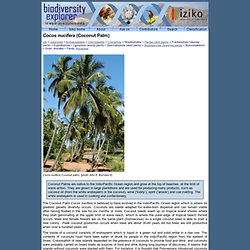
They are grown in large plantations and are used for producing many products, such as coconut oil (from the white endosperm in the coconut), wine ('toddy'), spirit ('arrack') and coir matting. The white endosperm is used in cooking and confectionery. The Coconut Palm Cocos nucifera is believed to have evolved in the Indo-Pacific Ocean region which is where its greatest genetic diversity occurs. The inside of a coconut consists of endosperm which is liquid in a green nut and solid white in a ripe one.
Uses Links. Natural rubber. This article is about the polymeric material "natural rubber".
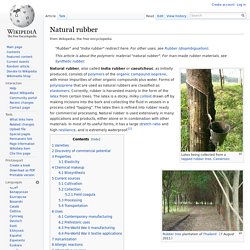
For man-made rubber materials, see Synthetic rubber. Gutta-percha. Gutta-percha is a name for a set of trees, mostly of the genus Palaquium, noted for their latex, or the rigid natural latex produced from the sap of these trees, particularly from Palaquium gutta.
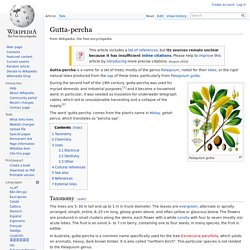
During the second half of the 19th century, gutta-percha was used for myriad domestic and industrial purposes,[1] and it became a household word. In particular, it was needed as insulation for underwater telegraph cables, which led to unsustainable harvesting and a collapse of the supply.[2] The word 'gutta-percha' comes from the plant's name in Malay, getah perca, which translates as "percha sap". Taxonomy[edit] Welcome to the National Alfalfa & Forage Alliance. Abelmoschus moschatus. Abelmoschus moschatus (Abelmosk, ambrette seeds, annual hibiscus, Bamia Moschata, Galu Gasturi, muskdana, musk mallow,[1] musk okra,[1] musk seeds, ornamental okra, rose mallow seeds, tropical jewel hibiscus,[1] Yorka okra; syn.
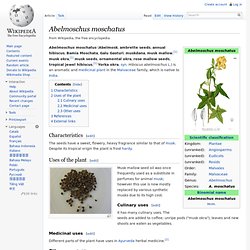
Hibiscus abelmoschus L.) is an aromatic and medicinal plant in the Malvaceae family, which is native to India. Characteristics[edit] Uses of the plant[edit] Musk mallow seed oil was once frequently used as a substitute in perfumes for animal musk; however this use is now mostly replaced by various synthetic musks due to its high cost. Culinary uses[edit] It has many culinary uses. Medicinal uses[edit] Different parts of the plant have uses in Ayurveda herbal medicine.[2]
Opopanax. Opopanax (also: Opoponax) refers to a number of gum resins with medicinal properties.
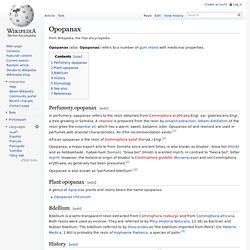
Perfumery opopanax[edit] In perfumery, opopanax refers to the resin obtained from Commiphora erythraea Engl. var. glabrescens Engl., a tree growing in Somalia. A resinoid is prepared from the resin by solvent extraction. Eragrostis. Some are dispersed by passing animals; the grains' hooks latch on to fur or hair, or to clothes.
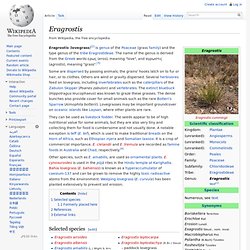
Others are wind or gravity dispersed. Several herbivores feed on lovegrass, including invertebrates such as the caterpillars of the Zabulon Skipper (Poanes zabulon) and vertebrates. The extinct bluebuck (Hippotragus leucophaeus) was known to graze these grasses. The dense bunches also provide cover for small animals such as the rare Botteri's Sparrow (Aimophila botterii). Pistacia lentiscus. Pistacia lentiscus (also mastic; Greek: μαστίχα mastíkha ) is a dioecious evergreen shrub or small tree of the pistacio genus growing up to 4 m (13 ft) tall which is cultivated for its aromatic resin, mainly on the Greek island of Chios.[1] Description[edit]
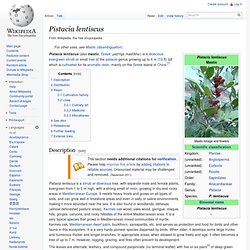
Inga. Inga (common name shimbillo) is a genus of small tropical, tough-leaved, nitrogen-fixing trees[2] and shrubs, subfamily Mimosoideae.

Inga's leaves are pinnate, and flowers are generally white. Many of the hundreds of species are used ornamentally. Several related plants have been placed into this genus at one time, for example Yopo (Cohoba, Mopo, Nopo or Parica - Anadenanthera peregrina -, as Inga niopo).[3] The seeds are covered with sweet white powder. The pulp covering the seeds is lightly fibrous and sweet, and rich in minerals; it is edible in the raw state. Loofah Plant Seeds Absorb Organic Pollutants and Heavy Metals from Wastewater. Seeds and oils from the plant that produces the loofah sponge could help purify wastewater and prevent the spread of waterborne diseases in the developing world, according to a scientist speaking today at the 17th Annual Green Chemistry & Engineering Conference in Bethesda, Md.
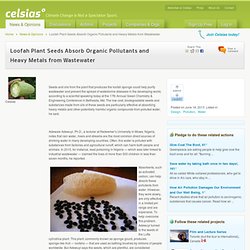
The low-cost, biodegradable seeds and substances made from oils of these seeds are particularly effective at absorbing heavy metals and other potentially harmful organic compounds from polluted water, he said. Medicago sativa. Leguminosae Author: Dr John Frame Common names.
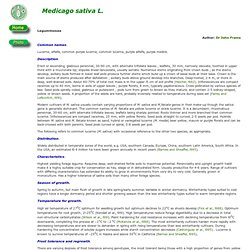
Lucerne, alfalfa, common purple lucerne, common lucerne, purple alfalfa, purple medick. Description. How Balsams are Harvested for Perfume « Bois de Jasmin. Peru Balsam is one of the workhorses in a perfumer’s palette providing a solid base note and voluptuous drydown. It’s a resinous material that, depending on the extraction method and provenance, can smell either warm and ambery or smoky and spicy.
When you enjoy perfumes like Hermès Elixir des Merveilles, Serge Lutens Amber Sultan, or Yves Saint Laurent Opium, you’re admiring the complexity of this interesting note. I have enjoyed experimenting with Peru balsam ever since my early days in perfumery school, but it was only last year that I discovered how it’s grown and collected. Tolu Balsam, Benzoin, Styrax and Oriental Balsamic Notes. Balsamic: heavy, sticky, sweet, unctuous scent, usually from an aromatic resin.
If you think of balsamic vinegar whenever you read about balsamic notes in perfumery, you are not far off. They have a similar sticky-sweet, rich character as a true wooden cask aged balsamic vinegar. The oud trend and the fascination with the East is nothing new in perfumery. Coir. Segregation of coir fibre Coir /ˈkɔɪr/ is a natural fibre extracted from the husk of coconut and used in products such as floor mats, doormats, brushes, mattresses, etc.
Tragacanth. Astralagus gummifer Tragacanth is a natural gum obtained from the dried sap of several species of Middle Eastern legumes of the genus Astragalus, including A. adscendens, A. gummifer, A. brachycalyx,[1][2] and A. tragacanthus. Some of these species are known collectively under the common names "goat's thorn" and "locoweed". Essential Oil Properties by Plant Part - Shining Sun Aromatherapy. The heart of my practice is Wisdom of the Earth Essential Oils…exquisite, powerful plant and tree medicines that can profoundly affect our health and well-being. They support and protect us in illness, and increase our vibrancy and positive spirit in health. Because our Wisdom of the Earth Reference Guide (spiral bound, 80+ pages) gives a comprehensive profile of each of the essences in our portfolio, including botanical name, country of origin/production information, application and usage suggestions, and key healing properties, I do not duplicate that information on this website.
However, I do categorize our entire essence portfolio according to the plant or tree part from which they are produced (e.g., root, flower petal), and describe some common therapeutic properties associated with each category. Pure Essential Oils from Citrus Peels. ناردين The Oil in the Alabaster Box – Spikenard Giveaway. Tonight we taking a fragrant journey back in time. We also have a gift to give away. Are you spending too much on perfume? Here is a scented tale for you. Jatamansi or Spikenard perfume ingredient, Jatamansi or Spikenard fragrance and essential oils Nardostachys jatamansi. Lat. Name - Patrinia jatamansi D. Don. Skin Deep® Cosmetics Database. Coumarin, Tonka Beans : Perfume Notes « Bois de Jasmin. Factsheet - Leucaena leucocephala. Tabebuia. 3 seeds with septum and valves of split pod of Tabebuia sp. at MHNT. Botany 115 Economic Plant Families. Legumes containing water soluble gums and natural dyes:
Essential First Aid Item: Activated Carbon. World Checklist of Selected Plant Families: Royal Botanic Gardens, Kew. The editors of WCSP would first like to thank the users for the more than 1000 emails of feedback they send each year. Argania spinosa information from NPGS. Genetic resources of agroforestry trees. Tragacanth. Date Palms. Chemical free Handmade Paper from DatePalm Leaf Fibre, the Agro Waste. Omani inventor mulls palm leaf waste-to-paper undertaking. MUSCAT — Omani inventor Mustafa Salim Abdullah Barami, 25, who has devised a patented process to convert palm leaf waste into commercially valuable paper is weighing plans to set up an industrial-scale paper manufacturing plant in the Sultanate, Oman daily Observer reported Tuesday.
He won a coveted second place in the Industrial Innovation Fair Oman last year for his groundbreaking waste-to-paper project. He was felicitated Monday, along with a number of Omani entrepreneurs, who will represent Oman at the Global Entrepreneurship Summit due to be held in Dubai next month. A graduate of Sultan Qaboos University with a degree in Chemistry and Petrochemicals, Mustafa has sought a patent for his technique of producing fiber — the basic raw material for paper production — from palm leaf waste. TANGALOA FREQUENTLY ASKED QUESTIONS (FAQS) The environments of copra plantations are man-made farming operations. Therefore, harvesting coco palm trunks for milling has no impact on any natural environment. The ethnobotany of Christ's Thorn Jujube (Ziziphus spina-christi) in Israel. Kenaf. Kenaf. About The Kenaf Plant. New Uses for Kenaf. Kenafusa. TreeHugger. Colza oil. Linenandhempcommunity.
Hemp. Hemp / Cannabis. Cannabis Review.